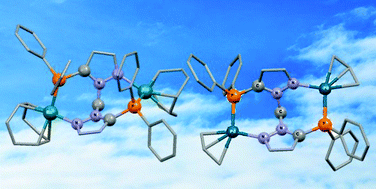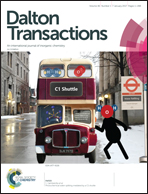Coordination of bis(azol-1-yl)methane-based bisphosphines towards RuII, RhI, PdII and PtII: synthesis, structural and catalytic studies†
Abstract
The coordination chemistry of bisphosphine ligands assembled on the five-membered heterocyclic platform of bis(azol-1-yl)methane viz.: bis(2-diphenylphosphinoimidazol-1-yl)methane (1), bis(5-diphenylphosphinopyrazol-1-yl)methane (2) and bis(5-diphenylphosphino-1,2,4-triazol-1-yl)methane (3) with RuII, RhI, PdII and PtII is described. The bisphosphines 1–3 react with elemental selenium to give the corresponding bis-selenoyl derivatives 4–6. The reactions of 1–3 with transition metal derivatives produce complexes with different coordination modes. Bisphosphine 1 showed a preference for the κ2-P,P mode of coordination, whereas bisphosphines 2 and 3, besides the κ2-P,P mode also showed a head-to-tail κ2-P,N coordination mode resulting in the formation of binuclear complexes [Rh2(COD)2{(CH2(1,2-C3H2N2PPh2)2)-κ2P,N}][BF4]2 (14), [Rh2(COD)2{(CH2(1,2,4-C2HN3PPh2)2)-κ2P,N}][BF4]2 (15), [Pd2(η3-C3H5)2{(CH2(1,2-C3H2N2PPh2)2)-κ2P,N}][BF4]2 (21) and [Pd2(η3-C3H5)2{(CH2(1,2,4-C2HN3PPh2)2)-κ2P,N}][BF4]2 (22). Several of these complexes have also been structurally characterized. The in situ generated RhI complex of bisphosphine 1 showed moderate to good selectivity in the hydroformylation of various styrene derivatives.



 Please wait while we load your content...
Please wait while we load your content...